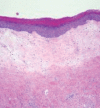Etiology, Clinical Features, and Diagnosis of Vulvar Lichen Sclerosus: A Scoping Review
- PMID: 32373174
- PMCID: PMC7191405
- DOI: 10.1155/2020/7480754
Etiology, Clinical Features, and Diagnosis of Vulvar Lichen Sclerosus: A Scoping Review
Abstract
Objective. Vulvar lichen sclerosus (VLS) is a chronic inflammatory disorder, which affects women of all ages. With numerous controversies as regards to the nomenclature, diagnosis and its association with neoplastic conditions, we decided to conduct a scoping review on this subject. Data Source. A review protocol was developed, and the Knowledge Resource Services website was used to do a search of articles pertaining to VLS with keywords "Vulvar," "Vulval," "diagnosis," "lichen sclerosus et atrophicus," "kraurosis," "vulvar dystrophy," and "Lichen Sclerosus". Study Selection. The search was limited to published data from the last ten years, i.e., from July 2009 onwards and in the English language. A total of 338 articles pertaining to VLS were obtained. Older data were accessed if particular information was sought for. Results & Conclusion. The presentation is bimodal, i.e., one in prepubertal girls (average age: 7.6 years) and the other in peri- and postmenopausal women (average age: 52.6 years). However, many cases also present during reproductive years. Studies suggest a multifactorial origin as far as etiology is concerned, including a genetic, autoimmune, hormonal, and local infectious background. It affects the genital labial, perineal, and perianal areas and manifests as a patchy, thin, glistening, ivory-white area. Diagnosis is mainly based on clinical features. Biopsy is seldom required. It has been well established as a precursor lesion of dVIN and vulvar carcinoma.
Copyright © 2020 Nilanchali Singh and Prafull Ghatage.
Conflict of interest statement
The authors declare that they have no conflicts of interest.
Figures




References
-
- What review is right for you? toronto, canada: knowledge synthesis team, knowledge translation program, St. Michael”s hospital. 2019. https://whatreviewisrightforyou.knowledgetranslation.net/
-
- Goldstein A. T., Marinoff S. C., Christopher K., Srodon M. Prevalence of vulvar lichen sclerosus in a general gynecology practice. Journal of Reproductive Medicine. 2005;50(7):p. 477. - PubMed
Publication types
LinkOut - more resources
Full Text Sources

